MICROBES IN HUMAN WELFARE for Class 12 BIOLOGY
INTRODUCTION
- In chapter 8, you have read that microbes cause a large number of diseases in human beings, animals and plants. But this should not make you think that all microbes are purely harmful; several microbes are useful to man in diverse ways. Some of the most important contributions of microbes to human welfare are like microbes in household products, microbes in industrial products, microbes in sewage treatments etc. etc. are discussed throughout the chapter.
INTRODUCTION
- In chapter 8, you have read that microbes cause a large number of diseases in human beings, animals and plants. But this should not make you think that all microbes are purely harmful; several microbes are useful to man in diverse ways. Some of the most important contributions of microbes to human welfare are like microbes in household products, microbes in industrial products, microbes in sewage treatments etc. etc. are discussed throughout the chapter.
Chapter Weightage
- The chapter contributes nearly 5-6 marks. Exam paper includes short and long answer question. Important topics are the following:
- Microbes in house hold products, LAB is very important,
- Industrial use.
- Sewage Treatment Plant
- Bio gas Plant with diagram.
Chapter Weightage
- The chapter contributes nearly 4-8 marks. Important topics are the following:
- Microbes in house hold products, LAB is very important,
- Industrial use.
- Sewage Treatment Plant
- Bio gas Plant with diagram.
Microbes in Household
- Microbes ke barey me hum generally tab bhi sunte hai wo lagbhag hamesha ek negative way me hota hai ki they cause many diseases jo ki sahi bhi hai but hamesha nhi. Kuch microbes ache hote hain and they are beneficial to us and some diseases cause karte hain (the pathogens). Pathogens ke bare me hum human health and disease waley chapter me padh chuke and ab is chapter me hamra focus hoga on the beneficial microbes.
- Household products me beneficial microbes ka bahut major role hai jo hum ab ek ek karke discuss karenge.
- Lactic acid bacteria lactic acid ko produce karta hai jo milk protein (casein) ko coagulate karta hai and dahi bn jati hai. Issi phenomenon ko hum ‘curdling of milk’ kehte hain. Curd ki nutritional value high hoti hai kyunki lactic acid bacteria jaise ki Lactobacillus acidophilus vitamin B12 bhi produce karta hai.
- Different types ke cheese bnane ke liye different microbes ka use hota hai jaise ki :
- Swiss Cheese ke liye we use Propionibacterium shermanii
- Roquefort Cheese ke liye fungus Penicillium roqueforti ka use hota hai.
- Camembert Cheese ke liye fungus Penicillium camemberti ka use hota hai.
- Dosa, idli, upma and bhature vgareh ke liye bhi dough me fermentation hoti hai jiski vajah se CO2 release hoti hai jo dough ko fluffy bnati hai. Iss process ke liye bhi hum ek gram positive bacteria ka use karte hain.
- Bread bnane ke liye Baker’s yeast (Saccharomyces cerevisiae) ka use hota hai.
- Toddy palm and coconut water ko sath me ferment karke Toddy (a traditional South Indian drink) ko prepare kiya jata hai.
- Tempeh, tofu and sufu yeah bhi fermented soybean se prepare kiye jate hain.
Swiss cheese :
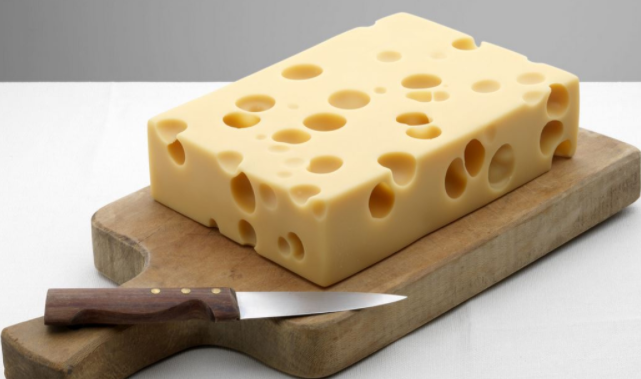
Roquefort cheese is shown below :
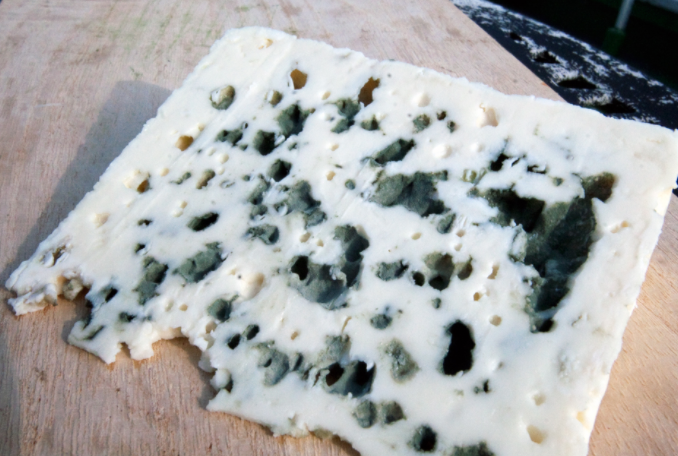
Camembert cheese is shown below :
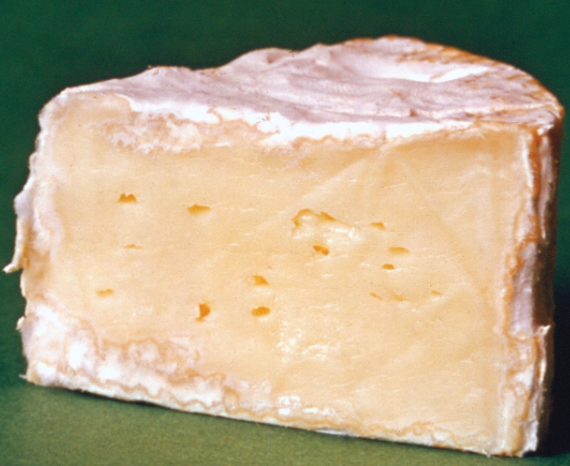
Toddy :
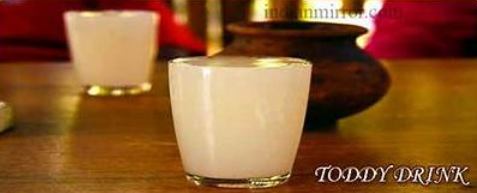
Fermented food like Tempeh, Tofu and Sufu are shown below serialwise :
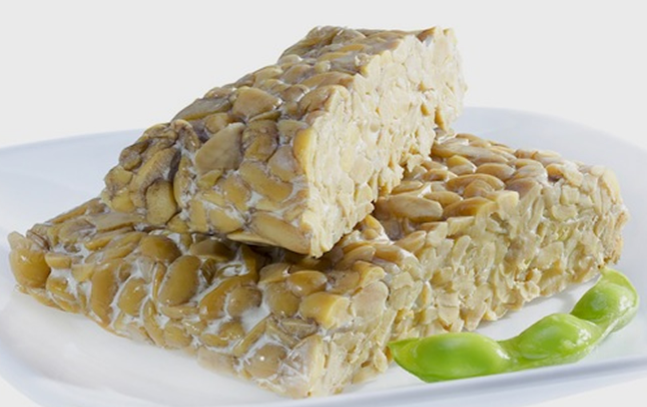

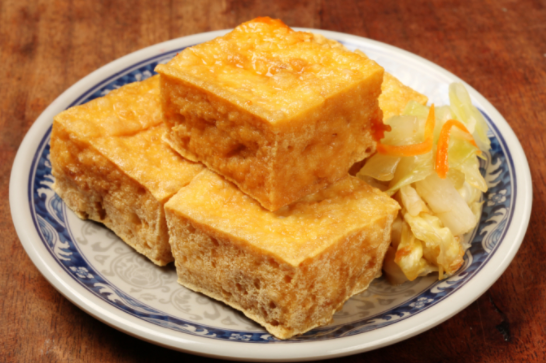
Microbes in Household
- Microbes are not 100% bad or 100% good. Some are useful to us, some are not and some are harmful. So in this section we will talk about microbes that we use daily in our household products.
- Lactic Acid Bacteria (LAB) converts milk into curd and this is one of the useful bacteria or the good bacteria that is also found in the human gut. For curdling we generally add a small amount of curd known as inoculum (which has many lactic acid bacterias) to the milk. As the bacteria Lactobacillus acidophilus grow in the milk they convert lactose (milk sugar) into lactic acid and lactic acid in turn causes coagulation of milk protein casein. For curdling reaction the milk should be at less than 40oC. LAB also produces vitamin B12 content during curdling and deficiency of this vitamin causes Pernicious Anemia
- The dough used for making bread, is fermented using baker’s yeast (Saccharomyces cerevisiae).
- Toddy a traditional drink of some parts of southern India is made by fermenting sap from palms.
- The large holes in ‘Swiss cheese’ are due to production of a large amount of CO2 by a bacterium named Propionibacterium shermanii.
- The ‘Roquefort cheese’ are ripened by growing a specific fungi (Penicillium roqueforti which is a common saprotrophic fungus) on them, which gives them a particular flavour.
- Camembert cheese is ripened by using fungi Penicillium camemberti
- Dosa, upma and idli are prepared by fermentation during which the dough is fermented overnight in presence of Leuconostoc mesenteroides (a type of lactic acid bacteria)
- Foods like tempeh, tofu and sufu are fermented foods prepared by fermenting soybean.
- Also known as microbial proteins are the edible unicellular microorganism which are rich in protein content and are used as protein supplement or a substitute for protein rich foods. These are suitable for human consumption and also for animal consumption. Microbes used for the purpose could be algae, fungi, yeast or even bacteria.
- The common SCP are spirulina, yeast and Fusarium graminearum (shown below in black & white diagram).
Figure given below shows rod shaped Lactobacillus bacteria :
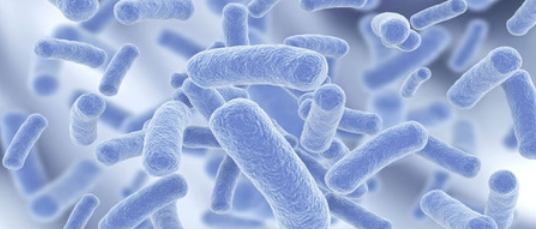
Single Cell Protein (SCP)
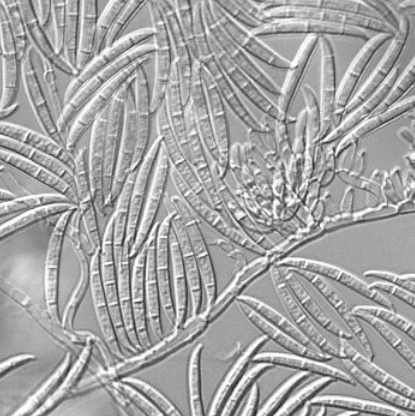
The image below shows powder of dried Spirulina (Single Cell Protein) which is rich in proteins :
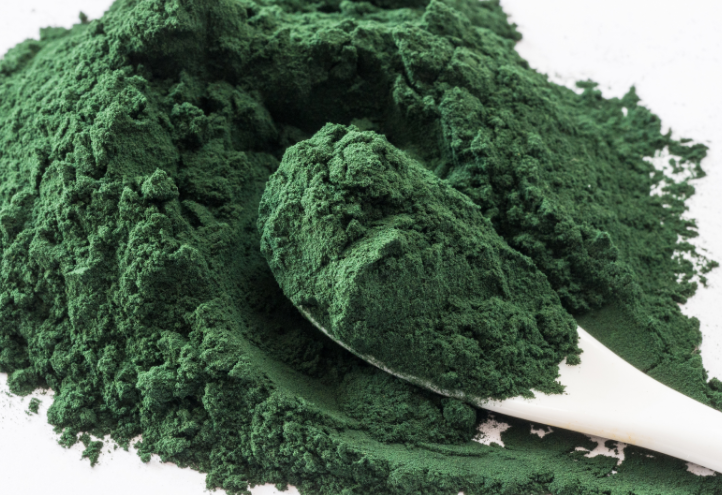
Next we have picture of Aspergillus niger
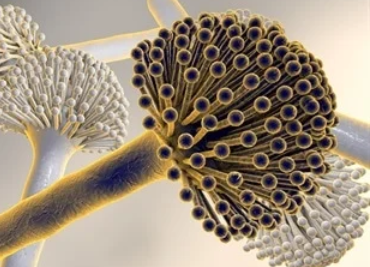
Microbes in Household
- Microbes are not 100% bad or 100% good. Some are useful to us, some are not and some are harmful. So in this section we will talk about microbes that we use daily in our household products.
- Lactic Acid Bacteria (LAB) converts milk into curd and this is one of the useful bacteria or the good bacteria that is also found in the human gut. For curdling we generally add a small amount of curd known as inoculum (which has many lactic acid bacterias) to the milk. As the bacteria Lactobacillus acidophilus grow in the milk they convert lactose (milk sugar) into lactic acid and lactic acid in turn causes coagulation of milk protein casein. For curdling reaction the milk should be at less than 40oC. LAB also produces vitamin B12 content during curdling and deficiency of this vitamin causes Pernicious Anemia
- The dough used for making bread, is fermented using baker’s yeast (Saccharomyces cerevisiae).
- Toddy a traditional drink of some parts of southern India is made by fermenting sap from palms.
- The large holes in ‘Swiss cheese’ are due to production of a large amount of CO2 by a bacterium named Propionibacterium shermanii.
- The ‘Roquefort cheese’ are ripened by growing a specific fungi (Penicillium roqueforti which is a common saprotrophic fungus) on them, which gives them a particular flavour.
- Camembert cheese is ripened by using fungi Penicillium camemberti
- Dosa, upma and idli are prepared by fermentation during which the dough is fermented overnight in presence of Leuconostoc mesenteroides (a type of lactic acid bacteria)
- Foods like tempeh, tofu and sufu are fermented foods prepared by fermenting soybean.
- Also known as microbial proteins are the edible unicellular microorganism which are rich in protein content and are used as protein supplement or a substitute for protein rich foods. These are suitable for human consumption and also for animal consumption. Microbes used for the purpose could be algae, fungi, yeast or even bacteria.
- The common SCP are spirulina, yeast and Fusarium graminearum (shown below in black & white diagram).
Figure given below shows rod shaped Lactobacillus bacteria :

Single Cell Protein (SCP)

The image below shows powder of dried Spirulina (Single Cell Protein) which is rich in proteins :

Next we have picture of Aspergillus niger

Microbes in Industrial Products
- At industry level microbes are used to synthesize beverages and antibiotics on an industrial scale where we grow microbes in huge vessels known as fermentors.
- For the production of alcohol we commonly use yeast species like Saccharomyces cerevisiae and Saccharomyces ellipsoidens for the alcoholic fermentation process, in which glucose is converted to ethanol and CO2.
- Production of beverages like beer, rum, brandy or whisky essentially depends on microorganisms known as fermenters.Saccharomyces cerevisiae commonly known as brewer’s yeast, is used to ferment sugars in malted cereals and fruit juices to produce ethanol.
- Depending on the type of the raw material used for fermentation and the type of processing (with or without distillation) different types of alcoholic drinks are obtained.
- Wine & Beer : without distillation
- Whisky, Brandy,Rum : with distillation.
→ Fermentation occurs only under anaerobic conditions.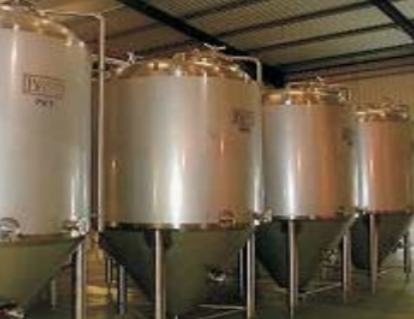
Chemical reaction occurring during alcoholic fermentation is shown below :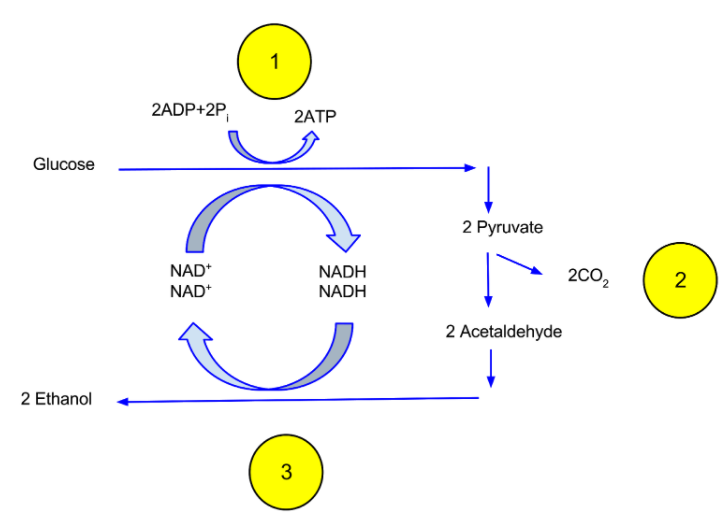
Antibiotics
- Anti means against and bio means life so antibiotics are compounds that act against mainly microbial life. Antibiotics are chemical substances, which are produced by some microbes and can kill or retard the growth of other (disease-causing) microbes.
- Alexander Fleming while working on Staphylococci bacteria, once observed a mould growing in one of his unwashed culture plates around which Staphylococci could not grow because a fungi called Penicillium notatum produced a chemical compound (named Penicillin by Alexander Flemming) which inhibited growth of Staphylococci. The full potential of penicillin as an effective antibiotic was established much later by Ernest Chain and Howard Florey.
- This antibiotic (Penicillin) was extensively used to treat American soldiers wounded in World War II. Fleming, Chain and Florey were awarded the Nobel Prize in 1945, for this discovery.
- Microbes are also used for commercial and industrial production of certain chemicals like organic acids, alcohols and enzymes.
- Aspergillus niger (a fungus) is a source of citric acid.
- Acetobacter aceti (a bacterium) is a source of acetic acid.
- Clostridium butyricum (a bacterium) is a source of butyric acid and Lactobacillus (a bacterium) of lactic acid.
- Yeast (Saccharomyces cerevisiae) is used for commercial production of ethanol.
- Bottled fruit juices bought from the market are clearer as compared to those made at home because the bottled juices are clarified by the use of enzymes such as pectinases and proteases. Pectinases are enzymes which are generally obtained from Byssochlamys fulva (a fungi).
- Lipases used in detergents for removing oil stains as these are lipid dissolving enzymes generally obtained from fungi like : Candida lipolytica and Geotrichum candidum.
- Enzyme Streptokinase also known as Tissue Plasminogen Activator (TPA) is produced by the bacterium Streptococcus and modified by genetic engineering is used as a ‘clot buster’ (fibrinolytic effect) for removing clots from the blood vessels of patients who have undergone myocardial infarction leading to heart attack.
- Cyclosporin A, is used as an immunosuppressive agent in organ-transplant patients, is produced by the fungus Trichoderma polysporum.
- Statins produced by the yeast Monascus purpureus have been used as blood-cholesterol lowering agents and it acts by competitively inhibiting the enzyme responsible for synthesis of cholesterol. This drug is usually given to patients whose arteries have been blocked by deposition of cholesterol to prevent any further blockages.
Fermented Beverages
→ Penicillin works by inhibiting cell wall synthesis in the bacteria and without cell wall, bacteria cannot survive.
Some natural sources of antibiotics are given in the table below :
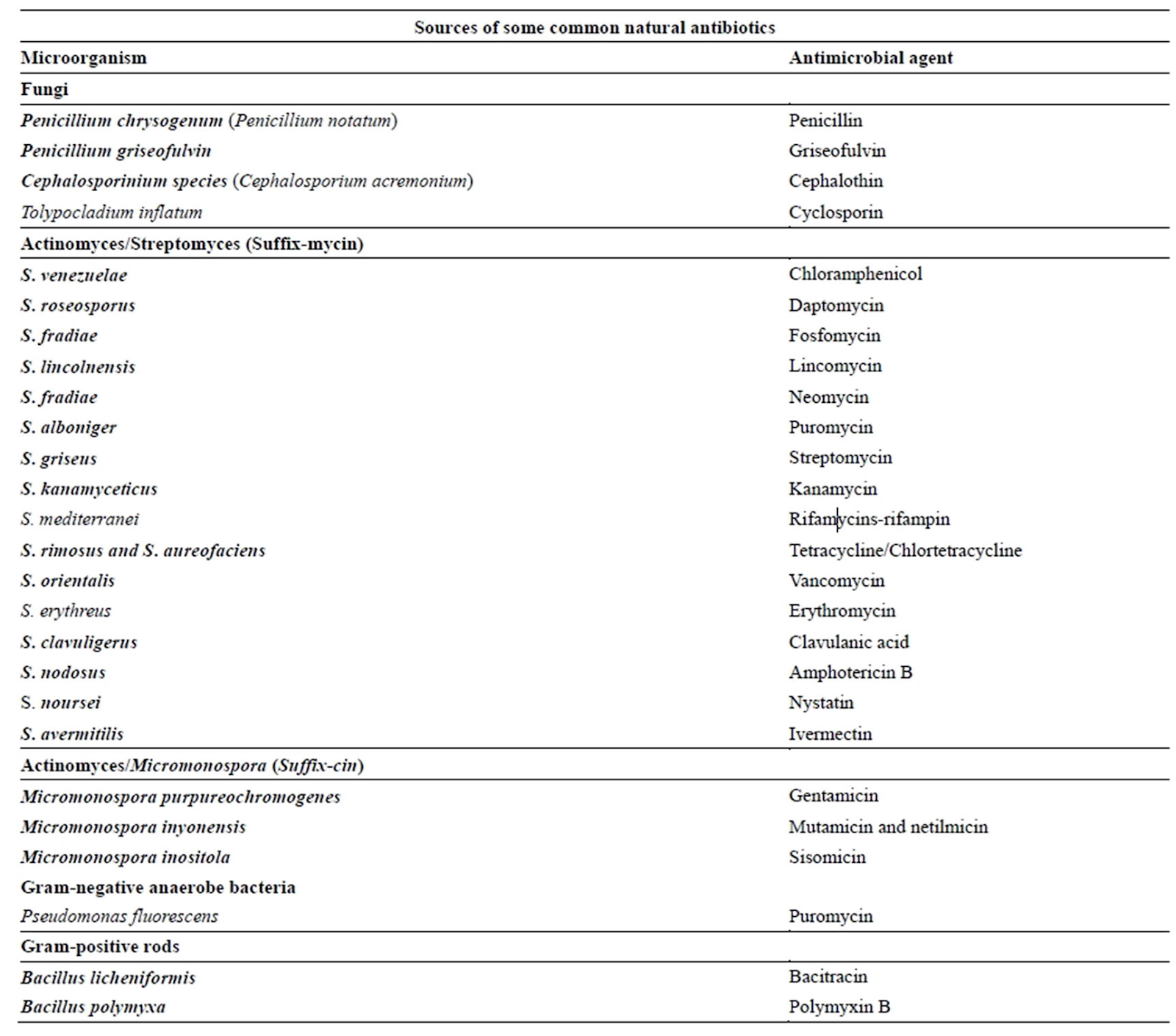
Chemicals, Enzymes and other Bioactive Molecules
Microbes in Industrial Products
- Iss section me hum dekhenge ki industrial products me microbes kaisey helpful hote hain. Toh industrial level pe mainly microbes ka use hota hai alcohol production, antibiotic production and for the production of chemicals and enzymes.
- Alcohol ka production glucose ki fermentation se hota hai jisme glucose se ethanol + CO2 as products obtain hote hain toh iss process ko hum alcoholic fermentation kehte hain jiske liye brewer’s yeast ka use kiya jata hai. Different yeast and different substrate ko use karke hum different alcoholic drinks prepare kr sakte hain for eg:
Saccharomyces cerevisiae and S. pastorianus se beer banti hai,
S. ellipsoideus se wine banti hai. - Hum sabko antibiotics ka function pta hai ki generally inko pathogenic bacteria ke infection ko khatam karne ke liye use kiya jata hai.
- Yeah antibiotics naturally kuch microbes secrete karte hain, sometimes as a defense mechanism and kabhi kabhi yeah bas metabolism ka product hote hain.
- Pehli antibiotic ki discovery Alexander Flemming ne ki thi (although by chance). Toh pehli antibiotic Penicillin thi. Iska yeah naam isiliye rakha gya kyunki yeah chemical compound hume fungi Penicillium se mila tha.
- Iske baad alag alag microbes se hume bahut sari alag alag antibiotics mili jinki summary neeche tabular form me given hai.
- Acetobacter aceti se hume acetic acid milta hai.
- Aspergillus niger se hume citric acid milta hai.
- Trichoderma polysporum ek fungus hai jinse hume Cyclosporin A milta hai jo ki ek immunosuppressive agent hai and organ transplant ke time rejection ko prevent karne ke liye use kiya jata hai.
- Yeast Monascus purpureus se statins ka production hota hai. Statins basically cholesterol synthesis ko inhibit karte hain toh yeah generally uss case me prescribe kiya jata jha ek individual ki arteries me bahut cholestrol deposit hokr blockages create kr rha hai jiski vjah se heart attack ke chances badh jate hain toh statins are given to patients who currently survived a heart attack.
- Enzyme Pectinase hume fungus Byssochlamys fulva se milta hai and pectinase ko hum packed juice ko clear karne ke liye use karte hain.
- Lipases aise enzymes hote hain which dissolve lipids toh hum inko oil stains remove karne ke liye use karte hain. Inka natural source hai fungus : Candida lipolytica & Geotrichum candidum.
- Enzyme Streptokinase blood clots ko dissolve karta hai and ye hume Streptococcus bacteria se milta hai.
In Alcohol Production
In Production of Antibiotics
In Production Of Chemical & Enzymes
Microbes in Sewage Treatment
- Humans generate waste water in huge amounts on a daily basis as water is the essential component from bathing, agriculture, washing etc etc and one of the major waste in the waste water in human excreta. This municipal waste-water is also called sewage. It contains large amounts of organic matter and microbes (although most microbes are pathogenic in this case). We cannot discharge this water as such into natural water bodies because it will contaminate the biological life there thus polluting it. So we treat this water so as to make it less contaminating before discharging it into natural water bodies.Treatment of waste water is done by the heterotrophic microbes naturally present in the sewage. This treatment is carried out in two stages:
- Primary Treatment
- Secondary Treatment
- This step involves physical removal of particles via filtration and sedimentation. Initially the floating debris is removed by filtration and then soil and small pebbles are removed by sedimentation.
- All solids that settle form the primary sludge, and the supernatant forms the effluent. The effluent is taken for secondary treatment.
- The primary effluent is sent to large aeration tanks where it is constantly agitated mechanically so as to pump air into it or we can say : ‘to increase amount of air’ in it. This will help in rapid growth of aerobic microbes which forms flocs (masses of bacteria associated with fungal filaments to form mesh like structures). The organic waste matter present in this sewage water acts as a food source for the aerobic microbes so the aerobic microbes while consuming the organic waste matter also consumes a large amount of oxygen from this water. As the microbial population grows and grows while degrading the organic waste, their need for oxygen also increases. They digest the organic waste and after the organic waste has been digested the aerobic microbe has no work left to do and hence the process of oxidising organic waste stops which significantly reduces the BOD (biochemical oxygen demand) of the effluent. BOD refers to the amount of the oxygen that would be consumed if all the organic matter in one liter of water were oxidised by bacteria.The sewage water is treated till the BOD is reduced (10-15% of raw sewage).
- In the next step, this sewage waste is passed to settling tanks where no more air is provided and these aerobic microbes start settling down. This sediment is called activated sludge. A small of this activated sludge is conserved to use as inoculum for the next batch and the rest is sent to anaerobic sludge digesters where anaerobic bacteria digest the microbes present in flocs. During this digestion as a mixture of H2S, CH4, CO2 is formed which is known as Biogas.
- The effluent from the secondary treatment plant is generally released into natural water bodies like rivers and streams or sometimes an additional step known as Tertiary treatment is carried out where we remove nitrates and phosphates by precipitation followed by chlorination to disinfect the water. After tertiary treatment the water is pure enough to drink which will be further cleansed at homes using RO etc. or it can be returned to natural water sources.
- The Ministry of Environment and Forests has already initiated the plans such as Ganga Action Plan and Yamuna Action Plan to save these major rivers of our country from pollution.
Primary Treatment
Secondary Treatment
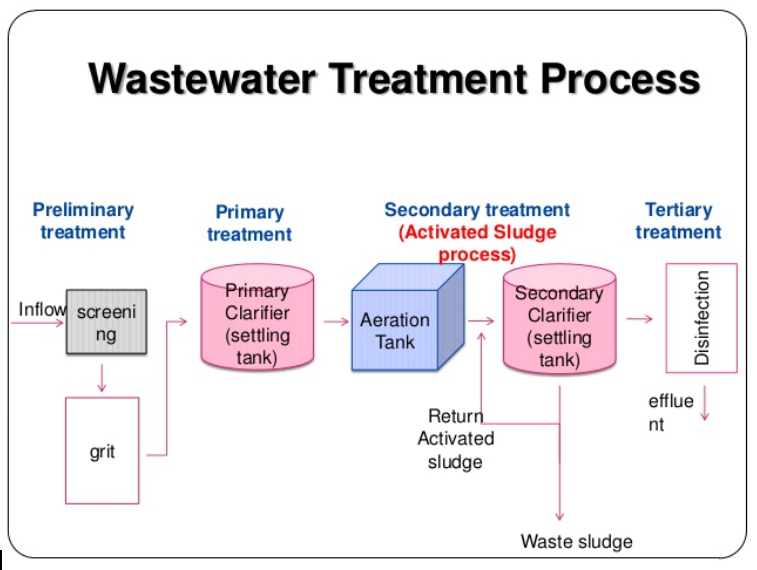
Microbes in Industrial Products
- At industry level microbes are used to synthesize beverages and antibiotics on an industrial scale where we grow microbes in huge vessels known as fermentors.
- For the production of alcohol we commonly use yeast species like Saccharomyces cerevisiae and Saccharomyces ellipsoidens for the alcoholic fermentation process, in which glucose is converted to ethanol and CO2.
- Production of beverages like beer, rum, brandy or whisky essentially depends on microorganisms known as fermenters.Saccharomyces cerevisiae commonly known as brewer’s yeast, is used to ferment sugars in malted cereals and fruit juices to produce ethanol.
- Depending on the type of the raw material used for fermentation and the type of processing (with or without distillation) different types of alcoholic drinks are obtained.
- Wine & Beer : without distillation
- Whisky, Brandy,Rum : with distillation.
→ Fermentation occurs only under anaerobic conditions.
Chemical reaction occurring during alcoholic fermentation is shown below :
Antibiotics
- Anti means against and bio means life so antibiotics are compounds that act against mainly microbial life. Antibiotics are chemical substances, which are produced by some microbes and can kill or retard the growth of other (disease-causing) microbes.
- Alexander Fleming while working on Staphylococci bacteria, once observed a mould growing in one of his unwashed culture plates around which Staphylococci could not grow because a fungi called Penicillium notatum produced a chemical compound (named Penicillin by Alexander Flemming) which inhibited growth of Staphylococci. The full potential of penicillin as an effective antibiotic was established much later by Ernest Chain and Howard Florey.
- This antibiotic (Penicillin) was extensively used to treat American soldiers wounded in World War II. Fleming, Chain and Florey were awarded the Nobel Prize in 1945, for this discovery.
- Microbes are also used for commercial and industrial production of certain chemicals like organic acids, alcohols and enzymes.
- Aspergillus niger (a fungus) is a source of citric acid.
- Acetobacter aceti (a bacterium) is a source of acetic acid.
- Clostridium butyricum (a bacterium) is a source of butyric acid and Lactobacillus (a bacterium) of lactic acid.
- Yeast (Saccharomyces cerevisiae) is used for commercial production of ethanol.
- Bottled fruit juices bought from the market are clearer as compared to those made at home because the bottled juices are clarified by the use of enzymes such as pectinases and proteases. Pectinases are enzymes which are generally obtained from Byssochlamys fulva (a fungi).
- Lipases used in detergents for removing oil stains as these are lipid dissolving enzymes generally obtained from fungi like : Candida lipolytica and Geotrichum candidum.
- Enzyme Streptokinase also known as Tissue Plasminogen Activator (TPA) is produced by the bacterium Streptococcus and modified by genetic engineering is used as a ‘clot buster’ (fibrinolytic effect) for removing clots from the blood vessels of patients who have undergone myocardial infarction leading to heart attack.
- Cyclosporin A, is used as an immunosuppressive agent in organ-transplant patients, is produced by the fungus Trichoderma polysporum.
- Statins produced by the yeast Monascus purpureus have been used as blood-cholesterol lowering agents and it acts by competitively inhibiting the enzyme responsible for synthesis of cholesterol. This drug is usually given to patients whose arteries have been blocked by deposition of cholesterol to prevent any further blockages.
Fermented Beverages
→ Penicillin works by inhibiting cell wall synthesis in the bacteria and without cell wall, bacteria cannot survive.
Some natural sources of antibiotics are given in the table below :

Chemicals, Enzymes and other Bioactive Molecules
Microbes in Production of Biogas
- Biogas is a mixture of H2S (in traces), CH4, CO2 (30-40%), H2(1-5%) gases but predominant gas is methane (CH4 =50-70%). The biogas is produced by certain anaerobic bacteria which grow on cellulosic material. As the major component of the gas produced by these microbes is methane so these microbes are generally known as methanogens. For eg: Methanococcus, Methanobacterium.
- These bacteria are commonly found in the anaerobic sludge during sewage treatment and also in the rumen of cattle where they digest the cellulosic food thus cattle dung (or Gobar) is rich in methanogens and hence cattle dung can be used as source for generation of biogas / gobar gas.
- Biogas plant generally has a 10-15 feet deep concrete tank which acts as a reservoir for bio-wastes and slurry.
- The floating cover is placed over the slurry in the digester tank so when biogas is formed continuously by the microbial activity, it will rise and we will know how much biogas is formed.
- The outlet is connected to a pipe to supply biogas to nearby houses. The spent slurry is removed through another outlet and may be used as fertiliser.
- The biogas thus produced is used for cooking and lighting.
- The technology of biogas production was developed in India mainly due to the efforts of Indian Agricultural Research Institute (IARI) and Khadi and Village Industries Commission (KVIC).

Components Of Biogas Plant
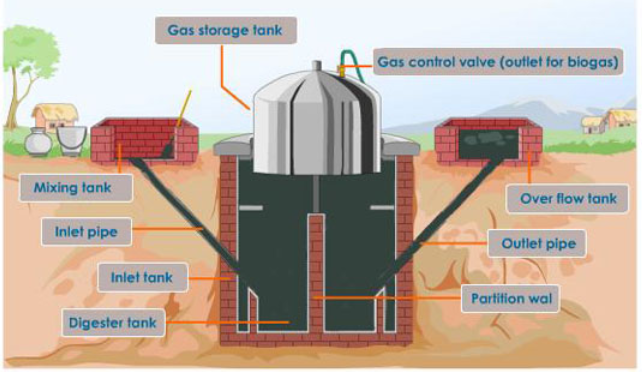
Microbes in Sewage Treatment
- Humans generate waste water in copious amounts and that too on a daily basis. Iss wastewater ka main component human excreta hota hai alongwith kitchen and industrial waste.
- Toh yeah pani na toh human reuse ke liye suitable hai or na hi hum isko as it is natural water bodies me return kar sakte hain kyunki it will contaminate the natural water bodies and vha ki life forms ke liye harmful hoga. So we need to treat it in such a way ki isme se jitna possible ho hum utna waste material nikal kr iss water ko itna purify kar de ki atleast hum isko safely natural water bodies me pass kar sake and yeah ganda pani vha koi problem cause na kare.
- Wastewater ki treatment 2 basic phases me hoti hai : Primary and Secondary treatment.
- Iss phase me hum wastewater ke uper jo debris float karti hai usko filtration se remove karte hain and fir hum isko sedimentation tank me bhej dete hai jha par sand, dirt and pebbles sediment kar jate hain and jo iss sediment ke uper pani hota hai usko hum supernatant / effluent kehte hain jisko secondary treatment ke liye bhej diya jata hai.
- Iss phase me biological treatment hota hai jha primary effluent ko hum aeration tanks me le jate hai jha usko mechanically agitate kiya jayega taki usme air pass kar sake. Air pass karne se iss primary effluent me jitne aerobic microbes thy wo grow karna shuru karenge jiski vajah se wo bahut jyada oxygen ka consumption hoga. Biochemical Oxygen Demand (BOD) oxygen ki wo amount hoti hai jo hume 1ltr sewage me organic matter ko oxidise karne ke liye chahiye hogi. BOD jitni high hogi, utni hi aerobic bacteria ki concentration jyada hogi and utna hi paani jyada polluted hoga. Toh jo shuru me wastewater aata hi uski BOD bahut jyada high hoti hai and secondary treatment ke baad aerobic microbe organic matter ko decompose karna shuru kar detey hai and dheere dheere aerobic microbe ka food (organic matter in wastewater) khatam hone lagta hai and in microbes ki population decrease karne lagti hai so that BOD of waste water is reduced to 10-15% of raw sewage.
- Iske baad effluent ko sedimentation tank me bheja jata hai jha microbial flocs settle down ho jate hain and this settled material is known as activated sludge and uper ke bache huye supernatant ko natural water bodies me bhej diya jata hai.
- Activated sludge ka ek small part as a inoculum use kiya jayega for next batch and baki ka anaerobic sludge digesters me bhej diya jata hai jha unko anaerobic bacteria unko digest kar denge and a mixture of gases like methane, CO2, H2S ki formation hoti hai.
- Tertiary treatment me hum nitrates and phosphate ko precipitation se remove karte hain and chlorine use karke water ko disinfect kiya jata hai so that water is pure enough to drink.
Primary Treatment
Secondary Treatment
Microbes as Biocontrol Agents
- The term biocontrol refers to the use of biological methods for controlling plant diseases and pests.
- The organic farmer generally works to create a system where the insects (pests) are not totally eradicated, but instead are kept at manageable levels by a complex system of checks and balances within a living ecosystem.
- Conventional farming practices often uses chemical methods (insecticides and pesticides etc) to kill both useful and harmful insects without any discrimination which has serious effects on a balanced ecosystem.
- So the use of biocontrol measures will greatly reduce our dependence on toxic chemicals and pesticides. Below we will see some such examples where some particular life forms help farmers get rid of harmful pests without harming the crop to great extent and also prevents use of pesticides etc which helps the farmer economically.
- The Ladybird (beetle with red and black markings), and Dragonflies are useful to get rid of aphids and mosquitoes, respectively.
- The bacteria Bacillus thuringiensis (often written as Bt) is available in sachets as dried spores which are mixed with water and sprayed onto vulnerable plants such as brassicas and fruit trees, where these are eaten by the insect larvae. In the gut of the larvae, the toxin is released and the larvae get killed. The bacterial disease will kill the butterfly caterpillars, but leave other insects unharmed.
→ We will be studying about bacillus thuringiensis in detail in the biotechnology unit so even if this part makes little or no sense at all here but we will just study and keep in mind that there's something called Bt which kills only specific harmful insects such as Cotton Bollworms etc and doesn’t harm other. - The fungus Trichoderma are free-living fungi which are very common in the root ecosystems. They are effective biocontrol agents of several plant pathogens.
- Baculoviruses (mainly of genus Nucleopolyhedrovirus) are pathogens that attack insects and other arthropods. These viruses have highly species-specific, narrow spectrum insecticidal applications. They have no negative impacts on plants, mammals, birds, fish or even on non-target insects.
- Bioherbicides are used for controlling the growth of weeds. Eg : Cochineal insects specifically feed on Opuntia : a common weed.
- Advantages of Biocontrol Agents : this is especially beneficial when beneficial insects are being conserved to aid in an overall integrated pest management (IPM) programme, or when an ecologically sensitive area is being treated.
Ladybird :

Dragonfly

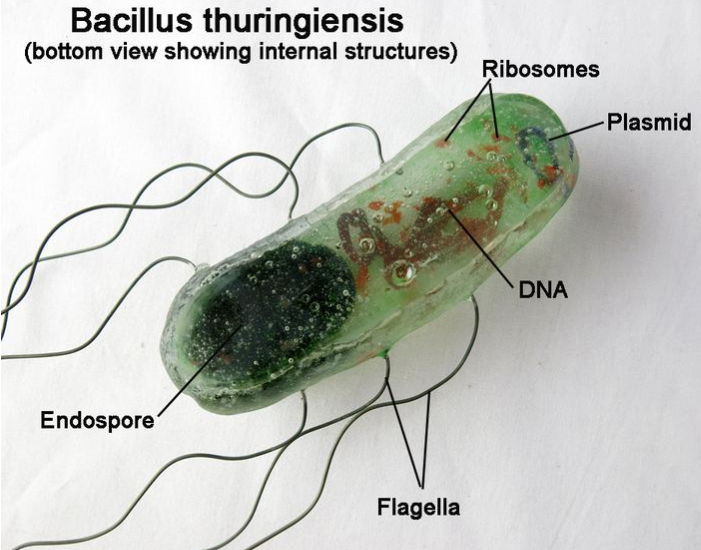
A Cochnieal insect is shown below :
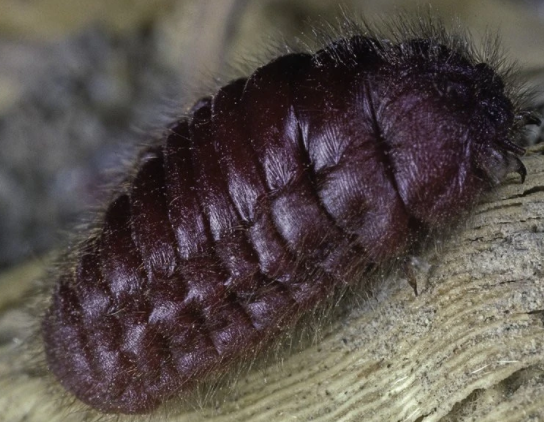
Microbes in Sewage Treatment
- Humans generate waste water in huge amounts on a daily basis as water is the essential component from bathing, agriculture, washing etc etc and one of the major waste in the waste water in human excreta. This municipal waste-water is also called sewage. It contains large amounts of organic matter and microbes (although most microbes are pathogenic in this case). We cannot discharge this water as such into natural water bodies because it will contaminate the biological life there thus polluting it. So we treat this water so as to make it less contaminating before discharging it into natural water bodies.Treatment of waste water is done by the heterotrophic microbes naturally present in the sewage. This treatment is carried out in two stages:
- Primary Treatment
- Secondary Treatment
- This step involves physical removal of particles via filtration and sedimentation. Initially the floating debris is removed by filtration and then soil and small pebbles are removed by sedimentation.
- All solids that settle form the primary sludge, and the supernatant forms the effluent. The effluent is taken for secondary treatment.
- The primary effluent is sent to large aeration tanks where it is constantly agitated mechanically so as to pump air into it or we can say : ‘to increase amount of air’ in it. This will help in rapid growth of aerobic microbes which forms flocs (masses of bacteria associated with fungal filaments to form mesh like structures). The organic waste matter present in this sewage water acts as a food source for the aerobic microbes so the aerobic microbes while consuming the organic waste matter also consumes a large amount of oxygen from this water. As the microbial population grows and grows while degrading the organic waste, their need for oxygen also increases. They digest the organic waste and after the organic waste has been digested the aerobic microbe has no work left to do and hence the process of oxidising organic waste stops which significantly reduces the BOD (biochemical oxygen demand) of the effluent. BOD refers to the amount of the oxygen that would be consumed if all the organic matter in one liter of water were oxidised by bacteria.The sewage water is treated till the BOD is reduced (10-15% of raw sewage).
- In the next step, this sewage waste is passed to settling tanks where no more air is provided and these aerobic microbes start settling down. This sediment is called activated sludge. A small of this activated sludge is conserved to use as inoculum for the next batch and the rest is sent to anaerobic sludge digesters where anaerobic bacteria digest the microbes present in flocs. During this digestion as a mixture of H2S, CH4, CO2 is formed which is known as Biogas.
- The effluent from the secondary treatment plant is generally released into natural water bodies like rivers and streams or sometimes an additional step known as Tertiary treatment is carried out where we remove nitrates and phosphates by precipitation followed by chlorination to disinfect the water. After tertiary treatment the water is pure enough to drink which will be further cleansed at homes using RO etc. or it can be returned to natural water sources.
- The Ministry of Environment and Forests has already initiated the plans such as Ganga Action Plan and Yamuna Action Plan to save these major rivers of our country from pollution.
Primary Treatment
Secondary Treatment

Microbes as Biofertilisers
- In this last section we will discuss how microorganisms play a role as biofertilizers thus helping us in reducing pollution caused due to chemical fertilisers.
- Biofertilizers are organisms that enrich the nutrient quality of the soil. The main sources of biofertilizers are bacteria, fungi and cyanobacteria
- Bacteria such as Rhizobium in roots of leguminous plants and other free living bacteria like Azospirillum and Azotobacter fix atmospheric nitrogen thus enriching the nitrogen content of the soil.
- When fungi forms symbiotic associations with plants it is known as Mycorrhiza. Members of genus Glomus form mycorrhiza. The fungal component in these associations absorbs phosphorus from soil and passes it to the plant and plants in turn provide food to fungus. Plants having such associations show other benefits also, such as resistance to root-borne pathogens, tolerance to salinity and drought, and an overall increase in plant growth and development.
- Cyanobacteria, the autotrophic microbes like Anabaena, Nostoc, Oscillatoria, etc. can fix atmospheric nitrogen and act as important fertilizers in paddy fields.
- Azolla pinnata is a free floating freshwater fern which coexists with cyanobacteria and fixes atmospheric nitrogen in paddy fields.
- Blue green algae also add organic matter to the soil and increase its fertility.
Figure given below shows the fern Azolla pinnata :
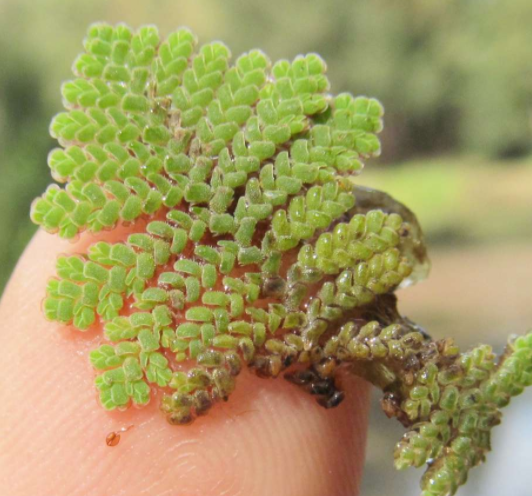
Figure given below shows Cyanobacteria :

Have a look at the picture below to see what the roots looks like with and without Mycorrhizae:

Microbes in Production of Biogas
- Ab iss section me padhenge ki kaise microbes biogas ke production me kaise role play karte hain. Kuch microbes jaisey ki Methanobacterium and Methanococcus; jinko hum methanogens kehte hai wo organic matter ko digest karke ek gases ka mixture release karte hai jisme methane, hydrogen sulphide, hydrogen etc hoti hai and iss gaseous mixture me methane ka percentage sabse jyada hota hai or issi gaseous ke mixture ko hum biogas kehte hain.
- Methanogens hume cows, buffalo ke rumen me milte hain jha yeah cellulose ko digest karte hain. So in animals ke dung me bhi in methanogens ki presence hoti hai. Toh hum inke dung ko use karke biogas bnate hain using a biogas plant.
- Biogas plant me generally ek lamba se concrete tank hota hai jisme slurry (dung + water + organic waste) dala jata hai.
- Dung me jo methanogens hai wo organic waste ko degrade krke biogas ki formation krte hain.
- Jab biogas sufficient amount me form ho jati hai toh usko ek outlet valve ke through distribute/use kiya jata hai.
BIOGAS PLANT
Summary
- Microbes are a very important component of life on earth. Not all microbes are pathogenic. Many microbes are very useful to human beings. We use microbes and microbially derived products almost every day. Bacteria called lactic acid bacteria (LAB) grow in milk to convert it into curd. The dough, which is used to make bread, is fermented by yeast called Saccharomyces cerevisiae. Certain dishes such as idli and dosa, are made from dough fermented by microbes. Bacteria and fungi are used to impart particular texture, taste and flavor to cheese. Microbes are used to produce industrial products like lactic acid, acetic acid and alcohol, which are used in a variety of processes in the industry. Antibiotics like penicillins produced by useful microbes are used to kill disease-causing harmful microbes. Antibiotics have played a major role in controlling infectious diseases like diphtheria, whooping cough and pneumonia. For more than a hundred years, microbes are being used to treat sewage (waste water) by the process of activated sludge formation and this helps in recycling of water in nature. Methanogens produce methane (biogas) while degrading plant waste. Biogas produced by microbes is used as a source of energy in rural areas. Microbes can also be used to kill harmful pests, a process called biocontrol. The biocontrol measures help us to avoid heavy use of toxic pesticides for controlling pests. There is a need these days to push for use of biofertilizers in place of chemical fertilisers. It is clear from the diverse uses human beings have put microbes to that they play an important role in the welfare of human society.
Microbes in Production of Biogas
- Biogas is a mixture of H2S (in traces), CH4, CO2 (30-40%), H2(1-5%) gases but predominant gas is methane (CH4 =50-70%). The biogas is produced by certain anaerobic bacteria which grow on cellulosic material. As the major component of the gas produced by these microbes is methane so these microbes are generally known as methanogens. For eg: Methanococcus, Methanobacterium.
- These bacteria are commonly found in the anaerobic sludge during sewage treatment and also in the rumen of cattle where they digest the cellulosic food thus cattle dung (or Gobar) is rich in methanogens and hence cattle dung can be used as source for generation of biogas / gobar gas.
- Biogas plant generally has a 10-15 feet deep concrete tank which acts as a reservoir for bio-wastes and slurry.
- The floating cover is placed over the slurry in the digester tank so when biogas is formed continuously by the microbial activity, it will rise and we will know how much biogas is formed.
- The outlet is connected to a pipe to supply biogas to nearby houses. The spent slurry is removed through another outlet and may be used as fertiliser.
- The biogas thus produced is used for cooking and lighting.
- The technology of biogas production was developed in India mainly due to the efforts of Indian Agricultural Research Institute (IARI) and Khadi and Village Industries Commission (KVIC).

Components Of Biogas Plant

Microbes as Biocontrol Agents
- Biocontrol agents ka matlab hai ki hum kuch microbes ko as insecticide or weedicide use kr sakte hain kyunki kuch microbes dusre microbes par selectively feed krte hain. Aisa krne se hume crop pe chemicals lagane ki jarurat nhi padegi. Ab kuch examples dekhte hain :
- Ladybird is used to get rid of Aphids or ladybird khud crop ko jyada nuksaan nahi pahuchati.
- Dragonflies are used to get rid of mosquitos.
- Spores of bacteria Bacillus thuringiensis selectively keval cotton bollworms and armyworms ko marte hain jabki baki kisi insect ya organism pe iska koi asar ni hota.
- Baculoviruses bahut hi specifically keval kuch harmful insects and arthropods ko infect karte hain. So these are used as narrow spectrum insecticides jiska baki kisi non targeted live form par koi asar nahi hota.
- Cochineal insects specifically feed on opuntia which is a notorious common weed.
Microbes as Biocontrol Agents
- The term biocontrol refers to the use of biological methods for controlling plant diseases and pests.
- The organic farmer generally works to create a system where the insects (pests) are not totally eradicated, but instead are kept at manageable levels by a complex system of checks and balances within a living ecosystem.
- Conventional farming practices often uses chemical methods (insecticides and pesticides etc) to kill both useful and harmful insects without any discrimination which has serious effects on a balanced ecosystem.
- So the use of biocontrol measures will greatly reduce our dependence on toxic chemicals and pesticides. Below we will see some such examples where some particular life forms help farmers get rid of harmful pests without harming the crop to great extent and also prevents use of pesticides etc which helps the farmer economically.
- The Ladybird (beetle with red and black markings), and Dragonflies are useful to get rid of aphids and mosquitoes, respectively.
- The bacteria Bacillus thuringiensis (often written as Bt) is available in sachets as dried spores which are mixed with water and sprayed onto vulnerable plants such as brassicas and fruit trees, where these are eaten by the insect larvae. In the gut of the larvae, the toxin is released and the larvae get killed. The bacterial disease will kill the butterfly caterpillars, but leave other insects unharmed.
→ We will be studying about bacillus thuringiensis in detail in the biotechnology unit so even if this part makes little or no sense at all here but we will just study and keep in mind that there's something called Bt which kills only specific harmful insects such as Cotton Bollworms etc and doesn’t harm other. - The fungus Trichoderma are free-living fungi which are very common in the root ecosystems. They are effective biocontrol agents of several plant pathogens.
- Baculoviruses (mainly of genus Nucleopolyhedrovirus) are pathogens that attack insects and other arthropods. These viruses have highly species-specific, narrow spectrum insecticidal applications. They have no negative impacts on plants, mammals, birds, fish or even on non-target insects.
- Bioherbicides are used for controlling the growth of weeds. Eg : Cochineal insects specifically feed on Opuntia : a common weed.
- Advantages of Biocontrol Agents : this is especially beneficial when beneficial insects are being conserved to aid in an overall integrated pest management (IPM) programme, or when an ecologically sensitive area is being treated.
Ladybird :

Dragonfly


A Cochnieal insect is shown below :

Microbes as Biofertilisers
- Kuch microbes soil ki fertility ko increase karne ki ability rakhtay hain toh we can use those microbes as biofertilizers.
- Microbes jaise ki Azospirillum & Azotobacter jo ki free living bacteria hai, yeah nitrogen fix karke soil me nitrogen ka content increase krte hain. Similar way me Rhizobium legume plant ki roots se associate hokr nitrogen ko fix karte hain.
- Kabhi kabhi fungus bhi higher plants ki root ke sath associate hokr Mycorrhiza form krti hai jha fungus ka main kaam hota hai plant ke liye phosphorus and water ka efficient absorption of plant iske badle fungus ko food provide karega.
- Azolla pinnata ek free living fern hai jo Blue Green Algae ke sath co exist krta hai. BGA is responsible for fixing nitrogen toh generally azolla ko paddy fields me use kiya jata hai to enhance ki nitrogen availability.
- Blue Green Algae / Cyanobacteria iske saath hi soil me organic matter ki amount bhi increase karte hai joki firse soil ki fertility of improve karta hai.
Microbes as Biofertilisers
- In this last section we will discuss how microorganisms play a role as biofertilizers thus helping us in reducing pollution caused due to chemical fertilisers.
- Biofertilizers are organisms that enrich the nutrient quality of the soil. The main sources of biofertilizers are bacteria, fungi and cyanobacteria
- Bacteria such as Rhizobium in roots of leguminous plants and other free living bacteria like Azospirillum and Azotobacter fix atmospheric nitrogen thus enriching the nitrogen content of the soil.
- When fungi forms symbiotic associations with plants it is known as Mycorrhiza. Members of genus Glomus form mycorrhiza. The fungal component in these associations absorbs phosphorus from soil and passes it to the plant and plants in turn provide food to fungus. Plants having such associations show other benefits also, such as resistance to root-borne pathogens, tolerance to salinity and drought, and an overall increase in plant growth and development.
- Cyanobacteria, the autotrophic microbes like Anabaena, Nostoc, Oscillatoria, etc. can fix atmospheric nitrogen and act as important fertilizers in paddy fields.
- Azolla pinnata is a free floating freshwater fern which coexists with cyanobacteria and fixes atmospheric nitrogen in paddy fields.
- Blue green algae also add organic matter to the soil and increase its fertility.
Figure given below shows the fern Azolla pinnata :

Figure given below shows Cyanobacteria :

Have a look at the picture below to see what the roots looks like with and without Mycorrhizae:

Summary
- Microbes are a very important component of life on earth. Not all microbes are pathogenic. Many microbes are very useful to human beings. We use microbes and microbially derived products almost every day. Bacteria called lactic acid bacteria (LAB) grow in milk to convert it into curd. The dough, which is used to make bread, is fermented by yeast called Saccharomyces cerevisiae. Certain dishes such as idli and dosa, are made from dough fermented by microbes. Bacteria and fungi are used to impart particular texture, taste and flavor to cheese. Microbes are used to produce industrial products like lactic acid, acetic acid and alcohol, which are used in a variety of processes in the industry. Antibiotics like penicillins produced by useful microbes are used to kill disease-causing harmful microbes. Antibiotics have played a major role in controlling infectious diseases like diphtheria, whooping cough and pneumonia. For more than a hundred years, microbes are being used to treat sewage (waste water) by the process of activated sludge formation and this helps in recycling of water in nature. Methanogens produce methane (biogas) while degrading plant waste. Biogas produced by microbes is used as a source of energy in rural areas. Microbes can also be used to kill harmful pests, a process called biocontrol. The biocontrol measures help us to avoid heavy use of toxic pesticides for controlling pests. There is a need these days to push for use of biofertilizers in place of chemical fertilisers. It is clear from the diverse uses human beings have put microbes to that they play an important role in the welfare of human society.
